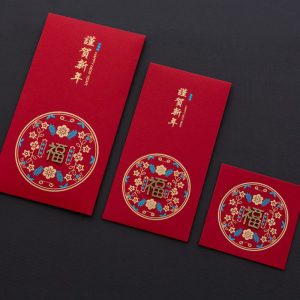Содержание
ToggleThe History and Culture of Red Envelopes

Introduction
Red envelopes, as an important symbol in Chinese culture, represent festive joy and blessings while carrying rich historical and cultural significance. This article will explore the origins, development, and significance of red envelopes in modern society.
The Origins of Red Envelopes
The history of red envelopes can be traced back to ancient China, with the earliest forms dating to the Han Dynasty (206 BC – 220 AD). At that time, people wrapped copper coins in red paper as amulets to ward off evil spirits and disasters. This tradition gradually evolved into distributing red envelopes during the New Year and other festivals to express blessings and good fortune.
Cultural Significance of Red Envelopes
In Chinese culture, red symbolizes auspiciousness, prosperity, and good luck. The red color of the envelope not only enhances the festive atmosphere but also signifies protection against evil and a wish for peace. Giving red envelopes is not only a way to express blessings but also an important means of conveying care and hope.
The Development of Red Envelopes
Over time, the form and content of red envelopes have continually changed. From the initial copper coin envelopes to later paper money envelopes, and now to modern electronic red envelopes, the forms of red envelopes have become increasingly diverse. Especially in the digital age, WeChat red envelopes and Alipay red envelopes have quickly become popular, serving as new ways for people to exchange blessings.
The Role of Red Envelopes in Modern Society
In modern society, red envelopes remain an indispensable part of festive celebrations. During important occasions such as the Spring Festival, weddings, and birthdays, red envelopes symbolize blessings and gifts and serve as a crucial means of social interaction. Through red envelopes, people convey blessings, express gratitude, and maintain family and social bonds.
Conclusion
As an important part of Chinese culture, red envelopes carry rich historical and cultural significance. From ancient times to the present, red envelopes have been a vehicle for expressing blessings and conveying care. In modern society, red envelopes not only continue the traditional culture but also integrate new elements of the times, continuing to play an important role.

Who Can Give Red Packets?
Red packets, also known as “hongbao” in Mandarin, are a cherished tradition in Chinese culture. They are not just simple monetary gifts but carry deep symbolic meanings of luck, prosperity, and blessings. Understanding who can give red packets and the customs associated with them is essential to fully appreciate this tradition. In this article, we will explore the significance of red packets and identify the individuals who typically give them.
The Significance of Red Packets
- Symbol of Good Luck:
- The red color of the envelope symbolizes good fortune and joy, making it a powerful symbol in Chinese culture.
- The money inside represents the giver’s blessings for the recipient’s prosperity and happiness.
- Cultural and Social Bonding:
- Giving red packets strengthens social bonds and reflects mutual respect and care within families and communities.
- They are a way to convey good wishes and blessings during significant life events and festive occasions.
Who Can Give Red Packets?
- Elders to Younger Generations:
- Family Tradition: It is customary for elders, such as parents and grandparents, to give red packets to children and younger relatives during the Lunar New Year. This act symbolizes the transfer of good luck and blessings from one generation to the next.
- Parental Blessings: Parents often give red packets to their children on their birthdays and other special occasions to wish them happiness and success.
- Married Couples to Younger Relatives:
- Marriage Status: In many Chinese traditions, once a person is married, they are expected to start giving red packets to their younger, unmarried relatives during the Lunar New Year and other celebrations.
- Symbolic of Adulthood: This practice signifies the transition from being a recipient to a giver, marking a step into adulthood and greater responsibility.
- Employers to Employees:
- Year-End Bonuses: Employers often give red packets to their employees as a form of year-end bonus or to celebrate the Lunar New Year. This gesture shows appreciation for the employees’ hard work and wishes them prosperity in the coming year.
- Incentives and Rewards: Red packets may also be given during company events, anniversaries, or as rewards for outstanding performance.
- Friends and Acquaintances:
- Weddings and Celebrations: Friends may give red packets during weddings, baby showers, or other significant life events to share in the joy and offer their blessings.
- Special Occasions: During festive seasons like the Lunar New Year, friends might exchange red packets as a token of goodwill and to strengthen their bond.
- Community and Charitable Acts:
- Supporting the Needy: Red packets are sometimes given to those in need, such as during charitable events or community gatherings, to share good fortune and support the less fortunate.
- Cultural Preservation: Community leaders and organizations may distribute red packets during cultural festivals to preserve traditions and foster community spirit.
Modern Adaptations
- Digital Red Packets:
- With the advent of digital payment platforms, giving red packets has become more convenient. Digital red packets are popular on platforms like WeChat and Alipay, especially among the younger generation.
- These digital envelopes retain the traditional spirit while adapting to modern technological advancements.
- Customised Red Envelopes:
- Many people now opt for customised red envelopes to add a personal touch. Customised red envelope suppliers offer a range of designs that cater to specific preferences and occasions.
- Businesses and individuals can design red packets that reflect their brand or personal style, making the giving experience more unique and meaningful.
Conclusion
The act of giving red packets is deeply rooted in Chinese culture and extends beyond mere monetary value. It symbolizes good luck, blessings, and the strengthening of social and familial bonds. Understanding who can give red packets and the significance behind them enriches the tradition and ensures its continuity. Whether through traditional or modern means, the red packet remains a vital part of Chinese celebrations and cultural heritage.

Rules for Red Envelopes: A Guide to Giving and Receiving
Red envelopes, or “hongbao,” are an integral part of Chinese culture, especially during festive occasions. While the tradition is rich and meaningful, there are specific rules and etiquette that one should follow to ensure the gesture is appropriate and respectful. This guide outlines the key rules for giving and receiving red envelopes.
1. Choosing the Right Envelope
- Color and Design:
- Red is Essential: The envelope must be red as this color symbolizes good luck, joy, and prosperity.
- Design Matters: Choose designs that are appropriate for the occasion. For instance, envelopes for weddings often feature symbols like double happiness, while those for Chinese New Year may have images of the zodiac animal of the year.
- Avoiding Certain Colors:
- No White or Black: These colors are associated with funerals and mourning and are considered inappropriate for red envelopes.
2. Amount of Money
- Even Numbers Preferred:
- Good Luck in Pairs: Even numbers are associated with good luck. For instance, giving amounts like 200, 400, or 800 is common. However, avoid the number 4 (e.g., 40, 400) because it sounds like the word for “death” in Chinese.
- Significant Numbers:
- Eight is Great: The number 8 is particularly auspicious as it sounds like the word for wealth. Amounts like 88 or 888 are highly favorable.
- Avoid Fours: As mentioned, the number 4 is unlucky, so amounts like 40, 444, or 4000 should be avoided.
- Crisp, New Bills:
- Presentation Matters: Always use new, crisp bills as they signify respect and good luck. Old or torn bills are considered disrespectful.
3. Giving the Red Envelope
- Proper Timing:
- Special Occasions: Red envelopes are typically given during Chinese New Year, weddings, birthdays, and other significant celebrations. Ensure you give them at the appropriate time during these events.
- Two Hands:
- Respectful Gesture: Always present the red envelope with both hands as a sign of respect. The recipient should also accept it with both hands.
- Respectful Language:
- Blessing Words: When giving the red envelope, accompany it with words of blessing or good wishes. For example, during Chinese New Year, you might say “Gong Xi Fa Cai” (Wishing you prosperity).
4. Receiving the Red Envelope
- Acceptance with Both Hands:
- Show Respect: Accept the red envelope with both hands as a sign of gratitude and respect.
- Expressing Thanks:
- Gratitude: Immediately thank the giver with appropriate words, such as “Xie Xie” (Thank you).
- Do Not Open Immediately:
- Privacy Matters: It is considered impolite to open the red envelope in front of the giver. Wait until you are in a private setting to open it.
5. Special Considerations
- Children and Unmarried Adults:
- Recipients: Traditionally, children and unmarried adults receive red envelopes from older, married relatives or family friends.
- Married Couples:
- Givers: Once married, individuals transition from being recipients to givers, especially during Chinese New Year and family gatherings.
- Professional Contexts:
- Workplace Etiquette: Employers often give red envelopes to employees during Chinese New Year as a bonus. Ensure the amount is fair and considerate of the employee’s contributions.
- Charitable Giving:
- Community Spirit: Red envelopes can also be given to support community events or charitable causes. This is a way to share good fortune and blessings with others.
Conclusion
Understanding and following the rules of red envelopes is essential to maintaining the respect and meaning behind this cherished tradition. By choosing the right envelope, giving an appropriate amount, and observing proper etiquette, you can ensure your gesture is received with the intended respect and goodwill. Whether you are giving or receiving, these guidelines help preserve the cultural significance and joy associated with red envelopes.